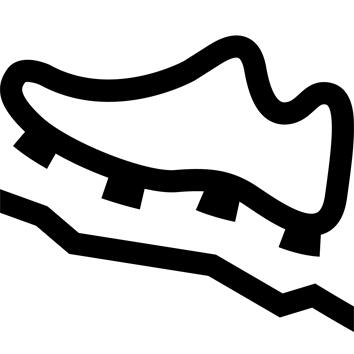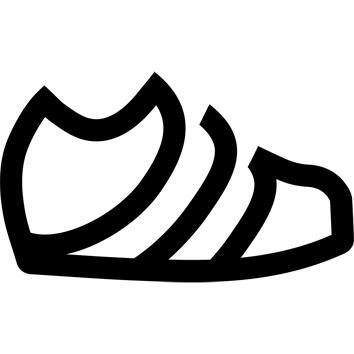How we calculate the frequency and intensity of occasional use of the MH100 MID WP hiking boot
We have classified our products in terms of performance and functionality to suit 3 levels of mountain hiking:
- Occasional: about ten hikes a year, lasting 3 to 4 hours, less than 10 km and less than 700 m ascent.
- Regular: about twenty outings a year. 4 to 6 hours, 10 to 20 km, 700 to 1200 m ascent per outing.
- Intensive: more than 20 outings per year. More than 6 hours, more than 20 km, 1200 to 2000 m ascent per outing.
What is the Outdoor Contact insole used in the MH100 MID WP hiking boot?
New high-performance outsole with our exclusive new rubber compound developed by our experts. More grip, more resistance. The sole design is engineered for greater grip using 3D simulations and then tested in the laboratory to assess the coefficient of adhesion on different surfaces and conditions. Field tests in the mountains enable us to make the final validation with a panel of testers.
How is the waterproofness of the MH100 MID WP hiking boot tested?
In the laboratory, the shoe is placed in water up to halfway up the shaft on a mechanical arm that generates flexions in the shoe to simulate a number of steps. Thanks to this test, we can determine a time and a number of km that the shoe can cover while remaining dry. We then validate in the field and in the rain that the shoe lives up to its promise in use.
Extending waterproofing
To keep your feet dry, we recommend using a waterproof gaiter or mini-gaiter to protect the upper part of the shoe from water ingress, as well as from stones and sand...
We recommend waterproofing your shoes twice a year with a waterproofing agent (search for "waterproofing agent" on our decathlon website), which will restore the original water repellency and combat external stains.
Which size to choose?
Some Decathlon stores are equipped with a test course.
1. Try on both shoes, standing up, with the socks you use for hiking.
2. Tighten the laces, taking care to distribute the tightening evenly.
3. Check two points:
- The heel does not lift off the front of the shoe when walking uphill.
- The foot does not slip and the toes do not touch the front when walking downhill.
4. Try on several sizes and models.
Use them progressively to make them fit your foot.
How to avoid blisters?
Blisters often appear when our skin is weakened by friction. To reduce the risk of blisters, we recommend:
- Choose hiking boots that are the right size for you.
- Wear appropriate socks.
- Lace and tighten your boots appropriately.
- Don't hesitate to readjust the tightness of your laces during practice, especially before starting a climb or descent.
- Wear your boots for a short outing when you first use them.
Which socks?
A waterproof shoe will be less breathable than a non-waterproof shoe. Socks such as the MH500, MH520 and MH900 in medium shank are therefore preferable to help wick away perspiration and limit overheating.
Optimize the performance of your shoes by replacing your insoles
The original insole in your shoes is designed to fit as many feet as possible. A change of insole can provide:
1. Better support: some insoles are preformed or reinforced to better support the arch of the foot.
2. Greater comfort: insoles can also provide warmth and/or cushioning.
3. Longer life: get back the support and comfort of your shoes by replacing the insole every season.
How to care for your shoes
- Allow to air dry.
- Remove dry mud with a fairly hard brush.
- For stains, clean with a brush and a little warm water.
- Allow to dry.
- Spray the stem with a waterproofing spray to restore water repellency.











